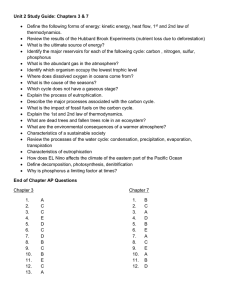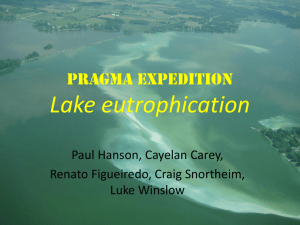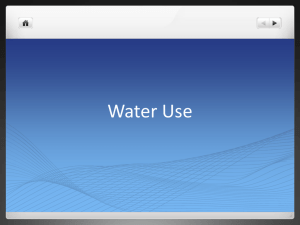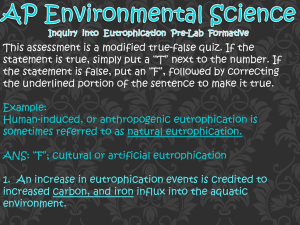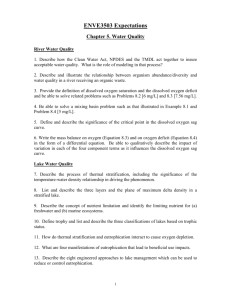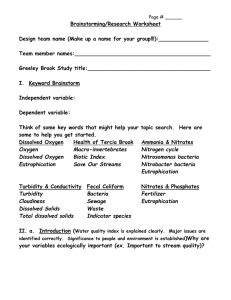Eutrophication Monitoring Programme (Reference Number: 2005-4) A. Introduction
advertisement
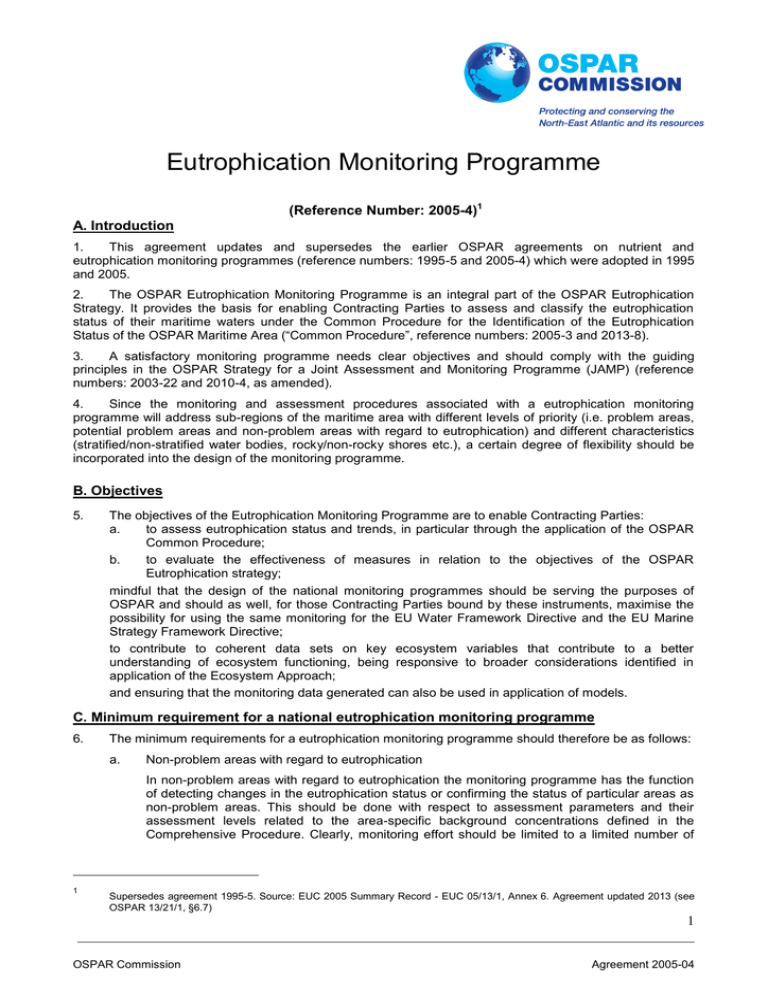
Eutrophication Monitoring Programme (Reference Number: 2005-4)1 A. Introduction 1. This agreement updates and supersedes the earlier OSPAR agreements on nutrient and eutrophication monitoring programmes (reference numbers: 1995-5 and 2005-4) which were adopted in 1995 and 2005. 2. The OSPAR Eutrophication Monitoring Programme is an integral part of the OSPAR Eutrophication Strategy. It provides the basis for enabling Contracting Parties to assess and classify the eutrophication status of their maritime waters under the Common Procedure for the Identification of the Eutrophication Status of the OSPAR Maritime Area (“Common Procedure”, reference numbers: 2005-3 and 2013-8). 3. A satisfactory monitoring programme needs clear objectives and should comply with the guiding principles in the OSPAR Strategy for a Joint Assessment and Monitoring Programme (JAMP) (reference numbers: 2003-22 and 2010-4, as amended). 4. Since the monitoring and assessment procedures associated with a eutrophication monitoring programme will address sub-regions of the maritime area with different levels of priority (i.e. problem areas, potential problem areas and non-problem areas with regard to eutrophication) and different characteristics (stratified/non-stratified water bodies, rocky/non-rocky shores etc.), a certain degree of flexibility should be incorporated into the design of the monitoring programme. B. Objectives 5. The objectives of the Eutrophication Monitoring Programme are to enable Contracting Parties: a. to assess eutrophication status and trends, in particular through the application of the OSPAR Common Procedure; b. to evaluate the effectiveness of measures in relation to the objectives of the OSPAR Eutrophication strategy; mindful that the design of the national monitoring programmes should be serving the purposes of OSPAR and should as well, for those Contracting Parties bound by these instruments, maximise the possibility for using the same monitoring for the EU Water Framework Directive and the EU Marine Strategy Framework Directive; to contribute to coherent data sets on key ecosystem variables that contribute to a better understanding of ecosystem functioning, being responsive to broader considerations identified in application of the Ecosystem Approach; and ensuring that the monitoring data generated can also be used in application of models. C. Minimum requirement for a national eutrophication monitoring programme 6. The minimum requirements for a eutrophication monitoring programme should therefore be as follows: a. Non-problem areas with regard to eutrophication In non-problem areas with regard to eutrophication the monitoring programme has the function of detecting changes in the eutrophication status or confirming the status of particular areas as non-problem areas. This should be done with respect to assessment parameters and their assessment levels related to the area-specific background concentrations defined in the Comprehensive Procedure. Clearly, monitoring effort should be limited to a limited number of 1 Supersedes agreement 1995-5. Source: EUC 2005 Summary Record - EUC 05/13/1, Annex 6. Agreement updated 2013 (see OSPAR 13/21/1, §6.7) 1 _______________________________________________________________________________________ OSPAR Commission Agreement 2005-04 parameters and a limited frequency of measurements, although spatial coverage should not be neglected. b. Problem areas with regard to eutrophication In problem areas with regard to eutrophication the monitoring programme should focus on longterm trends in nutrient concentration and on a selection of related eutrophication effect parameters, taking into account corresponding long-term trends in nutrient inputs. A larger number of parameters and a higher sampling frequency should be considered than is the case for non-problem areas, so as to satisfy statistical requirements. The spatial coverage should also be more focused than for non-problem areas. Monitoring should continue until the nonproblem area status is achieved. c. Potential problem areas with regard to eutrophication With regard to their unknown status, potential problem areas with regard to eutrophication should be monitored in the same manner as problem areas, for a trial period not exceeding five years. This should enable the area to be reclassified as either a problem area or a non-problem area with regard to eutrophication. 7. In implementing these minimum monitoring requirements Contracting Parties should focus on those eutrophication effects that are sufficiently closely linked to nutrient enrichment to be of value in indicating the eutrophication status of an area. The eutrophication effects should be selected on the basis of the assessment parameters listed in Table 1 of the Common Procedure. 8. If, following the classification of the maritime area in terms of eutrophication status, sub-regions (based for example on hydrographic characteristics) are identified within an area of particular eutrophication status (i.e. a problem area, a potential problem area or a non-problem area with regard to eutrophication), then the minimum monitoring requirements specified under § 5 should be applied to each of the sub-regions. 9. The spatial distribution of the monitoring stations should, prior to the establishment of the eutrophication status of the maritime area using the Common Procedure, be commensurate with the anticipated extent of eutrophication in the area under consideration as well as its hydrographic characteristics. Consequently, each Contracting Party should determine the optimum frequency per year and optimum locations for its monitoring stations. Where appropriate, efforts should be coordinated between Contracting Parties. 10. The minimum requirements for a eutrophication monitoring programme are specified in Tables 1 and 2. Contracting Parties should increase the scope and frequency of monitoring as they consider appropriate. 11. Contracting Parties identifying significant contributions of nutrients and/or organic material from areas under jurisdiction of another Contracting Party should enter into dialogue with a view to ensuring that monitoring by both parties supports the overall objectives of the eutrophication monitoring programme. 12. The Eutrophication Monitoring Programme forms part of the OSPAR Coordinated Environmental Monitoring Programme (the CEMP - reference number: 2010-01 (latest update)). Contracting Parties shall report the monitoring results for the parameters listed in Tables 1 and 2 in accordance with the arrangements for the CEMP agreed and updated periodically by OSPAR. ICES is currently the OSPAR data centre for marine environmental monitoring data, and according to the agreements of OSPAR, Contracting Parties are obliged to report their monitoring data to ICES by 1 September in the year following the year of monitoring using the agreed formats and should resolve any data processing issues with the ICES data centre. 13. The programmes and procedures for the assessment or classification by each Contracting Party of the eutrophication status of areas within its marine waters is set out in the OSPAR Eutrophication Strategy (reference number: 2010-03) and in the Comprehensive Procedure of the Common Procedure. Table 1. Nutrient enrichment 1 Non-problem areas 2,4 -1 NH4-N (µmol l ) Potential problem areas Problem areas + + + -1 + + + -1 + + + -1 + + + SiO4-Si (µmol l ) -1 - + + Salinity + + + 2,4 NO2-N 2,4 NO3-N 3,4 PO4-P 4 (µmol l ) (µmol l ) (µmol l ) 2 _______________________________________________________________________________________ OSPAR Commission Agreement 2005-04 Non-problem areas Temperature Potential problem areas + 5 Frequency About every three years during winter Problem areas + + Annually during winter when algal growth is at a minimum and during monitoring of direct and indirect effects (Notes to Table 1): + Action required Action discretionary 1 All parameters should be monitored in conjunction with area-specific ecosystem features. 2 Winter dissolved inorganic nitrogen (DIN) is the sum of NH4-N, NO2-N and NO3-N. 3 4 5 Winter dissolved inorganic phosphate (DIP) Monitoring of winter DIN, DIP and Si should be in conjunction with salinity measurements (see Common Procedure, §§ 4.26 and 4.29). Monitoring should include sufficient samples to confirm that the maximum winter nutrient concentration has been determined. Table 2. Direct and indirect eutrophication effects Non-problem areas Potential problem areas Problem areas + Phytoplankton -1 chlorophyll a (µg l ) - + Phytoplankton indicator -1 species (cells l ; species composition) - + species composition: + species composition: (genera and (genera and nuisance/potentially nuisance/potentially toxic species) toxic species) + TOC and POC2 Macrophytes, including macroalgae and 3 angiosperms - + biomass O2 concentration (mg l ; including % O2 saturation) - + (zoo) Benthic communities - + - annually during the algal growing season -1 4 Frequency + 1 2 3 4 1 + + biomass species composition, coverage, and reduced depth distribution + biomass and species composition (if time series already exist) + biomass, species composition and eutrophication indicator species Action required Action discretionary All parameters should be monitored in conjunction with area-specific ecosystem features. TOC: Total Organic Carbon; POC: Particulate Organic Carbon. In shallow areas, primarily in estuaries and coastal waters. With adequate frequency and area coverage D. Operational aspects 14. Sampling in support of the Eutrophication Monitoring Programme is carried out using ships in winter (for nutrients) and summer (for eutrophication effect parameters) adopting various spatial designs. Ships continue to provide flexible platforms for this work and guidelines support the minimum requirements covering spatial and temporal aspects. However, other platforms such as smartbuoys, gliders, towed devices and ferry-boxes have been developed which provide different temporal and spatial sampling capabilities. These are all suitable for delivering the data required for monitoring eutrophication parameters provided adequate quality assurance is in place. Where monitoring programmes are changed to make use of these technologies there should be a transition period to ensure the results obtained are at least as good as those derived from ship based sampling. It has often been found that these technologies, derived from research 3 _______________________________________________________________________________________ OSPAR Commission Agreement 2005-04 programmes, offer enhanced information compared to traditional monitoring surveys and are considered to be more efficient. In addition to these in situ platforms which are essential to provide ‘ground truth’, satellite and aerial remote sensing are also useful means of gathering data especially where a wide spatial and more timely coverage is required. 4 _______________________________________________________________________________________ OSPAR Commission Agreement 2005-04

